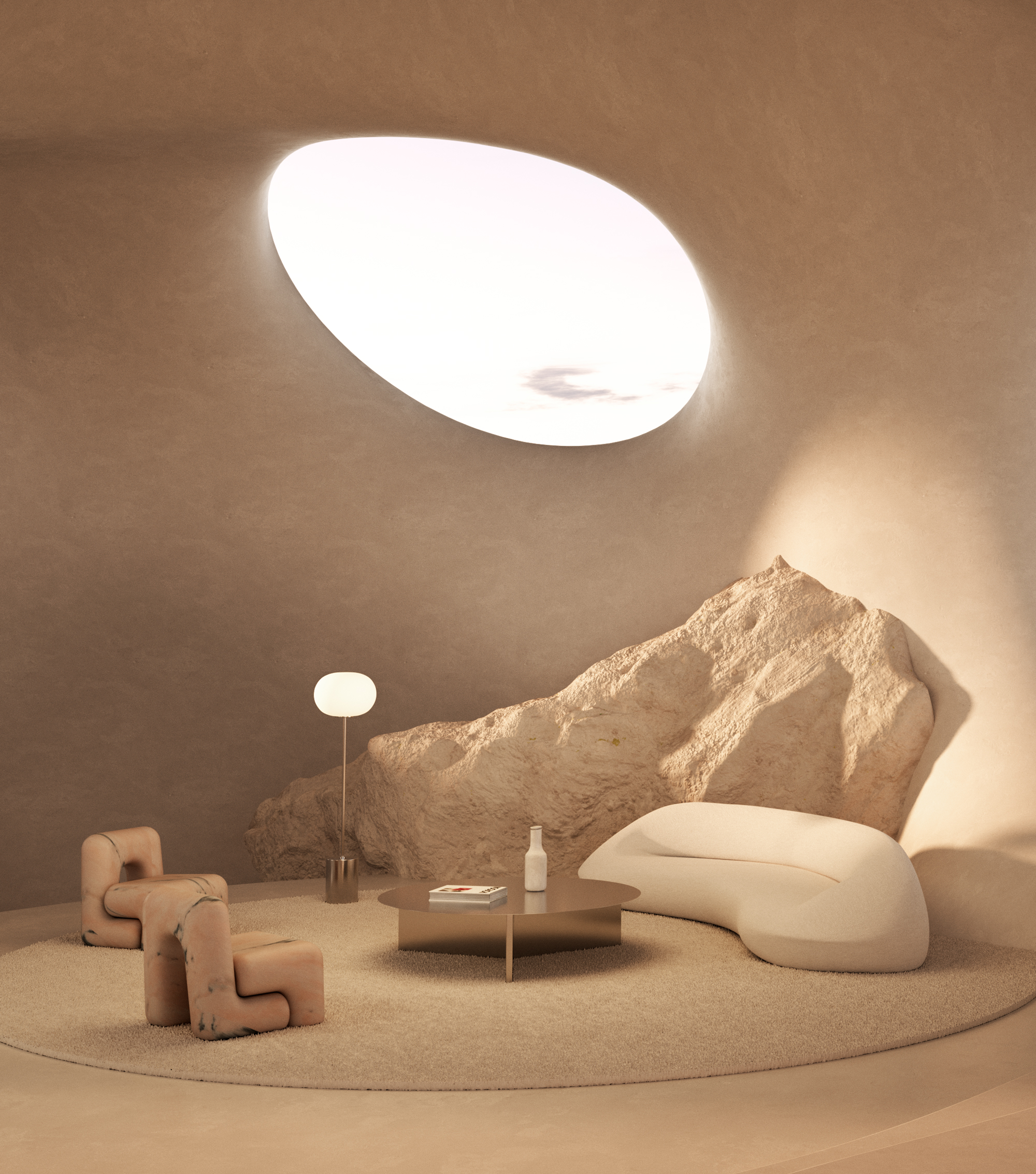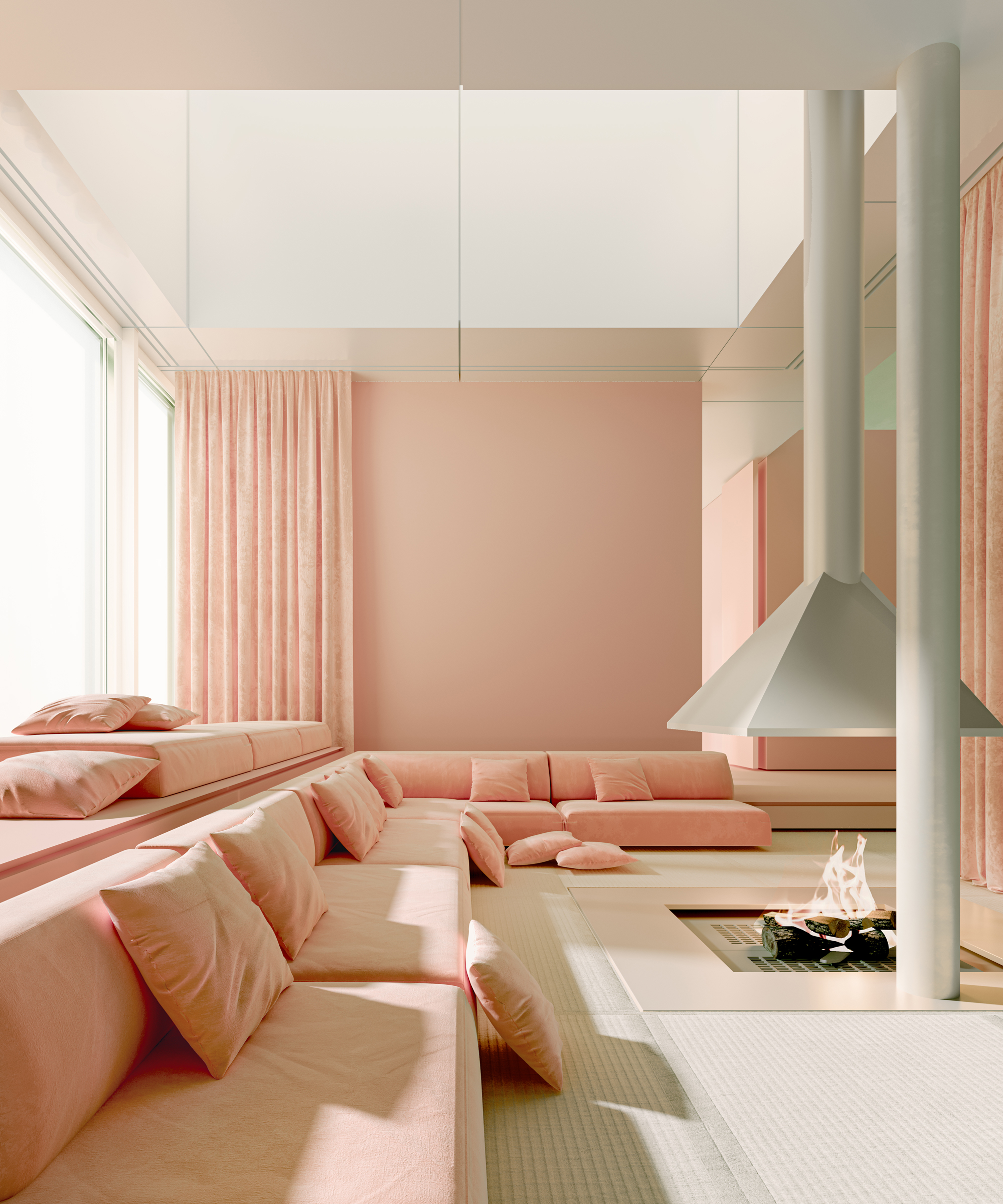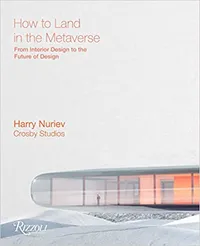Will the metaverse influence how we decorate our homes? It already is, say some experts...
As designers and architects begin experimenting in inhabitable virtual worlds known as the metaverse, futuristic aesthetics are starting to influence 'real-world' design


The metaverse, so far, has largely sat in my consciousness alongside cryptocurrency and NFTs. It's something that I know is happening in the background and that many people are incredibly passionate about, but if you were to ask me what it's really about, I couldn't tell you.
However, recently my ears have pricked up at mentions of the metaverse in design circles. While Mark Zuckerberg's recent reveal of his avatar that looked like 10-year-old computer game graphics didn't convince me that the metaverse was something that demanded any of my attention, hyper-realistic images of ethereal, other-worldly architecture and interiors being 'built' for virtual worlds has highlighted that this is fast becoming a platform for a new and invigorating exploration of design.
However, with no plans to inhabit a virtual world myself at this moment in time, I was interested to know what implications architecture and interior design in the metaverse would have on what I termed the 'real world'.
'To me, the term “real world” has no meaning,' world-renowned digital artist Andrés Reisinger is quick to tell me. 'I see a tangible world and a digital one, both real. The former remains and will remain an important reference, as it’s the one we can more easily and instantly associate to our human, bodily being.'
Andrés is one of a handful of designers I can see both being influenced by current interior design trends, and influencing the aesthetic of non-digital design, too. The relationship between designers and architects and digital spaces isn't straight forward, after all. And, when it comes to matters of designing for virtual worlds, we come to find out that not everyone is convinced.

In conversation with designers and architects for this piece, the name Andrés Reisinger was a recurring theme. Referring to himself as an 'unclassifiable' artist, Andrés is a prime example of how design can intersect both the physical and virtual worlds. The Buenos Aires-born artist is one of the world's most sought-after digital artists, with NFTs reaching eye-watering figures. He has also worked with furniture brand Moooi to translate his digital furniture into tangible products.
What is the Metaverse, and why does it matter to design?
Apple's CEO Tim Cook this week said that he wasn't 'really sure the average person could tell you what the metaverse is'. That may be true technically, but I'd venture it's not a completely alien concept, especially across a range of ages. 'Don't forget you've got a generation coming up who are natives to this idea of virtual worlds through games like Minecraft and Roblox,' says Tom Puukko, founder of Metaverse Interior Design, a start-up platform that looks to create a community of designers, architects and those seeking them for work in the metaverse.

The metaverse is, in basic terms, the creation of virtual worlds, however it's not one centralized space. 'It's probably one of the biggest real estate developments ever to happen,' Tom explains. 'If you just take something like Decentraland, they have essentially built something the same size as Dubai from the ground up. And that's just one Metaverse in its very early form.'
The Livingetc newsletters are your inside source for what’s shaping interiors now - and what’s next. Discover trend forecasts, smart style ideas, and curated shopping inspiration that brings design to life. Subscribe today and stay ahead of the curve.
The creation of these spaces is where design enters the equation, but as Tom explains, for the metaverse, it's a work-in-progress. 'As we often see with new tech platforms, at the beginning, the people doing the designing for it have a particular skill set, the coders and developers that are at the slightly "nerdy" end of design.'
'As the metaverse becomes more functional and is used more for tasks which might happen in the real world, people will be more demanding of the spaces than just wacky, novelty spaces,' he continues. 'They should actually start to perform well as spaces where you can meet people and perform tasks, something that will be better from people are skilled in creating these spaces in the real world.'
While graphic artists are by far the most prolific in the field, this is where Tom, and others, see the need for architects and interior designers to contribute to the design of these spaces.
Julia Schwartz, co-founder of Everyrealm, which has developed a portfolio of metaverse-based property, including The Row, agrees. 'The metaverse is only as exciting as the content that lives inside of it, so idea generation (and of course execution) is arguably the most important factor of development,' she tells us. 'People want to see things they wouldn’t come across in real life; they want wild experiences that help them escape from the realities of their day-to-day routines. Having a vision is crucial.'
Want to learn more about design in the metaverse?
You can pre-order How to Land in the Metaverse: From Interior Design to the Future of Design by Harry Nuriev of Crosby Studios now, released in April next year
Will the Metaverse influence 'real world' design?

This early period of the metaverse feels defined by a specific design aesthetic - one informed by the idea that there's no limits in this realm. 'I think this first interpretation has this kind of "Mars colony on acid" approach,' says Tom Puukko. 'There are bare open spaces, sand dunes and then these interesting organic shapes. I guess it comes down to the fact that you can break the rules of physics, so why not?'
It's a look that influential artists like Andrés Reisinger have spearheaded. 'From an aesthetic standpoint, the overall feel is oftentimes futuristic and hyper-realistic,' Andrés says. 'I think it’s a spontaneous evolution as elements of the physical world are transferred to a digital dimension. In my work, I strive to create a slightly odd, slightly distorted, but still familiar result: I am interested in raising questions, and that can only happen when you capture attention and create curiosity. Some creations are looking for further connections to the physical and natural realm, others are distancing themselves as much as possible.'
It's also an interior design trend that we're seeing permeate design in the physical world, too, but where it was incepted is a more complicated answer. 'Everything influences everything else, it is hard to say what originates what,' Andrés says.
'It feels like a natural place for design in the metaverse to go,' adds Tom. 'The primary palettes, lots of curves, very organic, playful and slightly surreal style might reflect some of the things happening in the real world anyway - I think it definitely draws influences from Memphis design, too.'

However, for Andrés, the influence of digital design is about more than just trends. 'I firmly believe that the digital can teach the physical world to speed up and make production processes easier,' he says, 'but more than that, it can teach us to create digital demand before physical production: the digital tools allows us to test, trial, undo and redo without incurring in the physical waste we keep on producing today.' For Andres, it's not just theory. His own design for an armchair called Hortensia, a cocooning piece of furniture textured with petals which became a viral sensation, was turned from digital art to physical form by furniture brand Moooi in 2021.
'On a more creative side, it will push us to escape and expand on what we’re used to believing are our visions, imagination, our possibilities of creation,' he adds.
Designing without limits
Yet, this idea of working without limits is also something that creates tensions between designing for the metaverse and the physical world. 'Real architecture is shaped by the challenges of building materials,' John Proctor, director of London architecture studio Proctor and Shaw tells us. 'Taking that away means a wholly different series of challenges you're engaging with.'
'There are plenty of architects who have had an impact who have built hardly anything, because their drawings and ideas are so evocative and powerful,' John continues, referencing architects such as Zaha Hadid (whose firm is now, interestingly, one of the big names you can see engaging with metaverse design in a significant way). 'But ultimately, whilst having impact, it's not architecture that makes a real difference - that architecture has real function.'
John also questions the real world applications. 'Curves are complex to build in real life but easy to draw and design,' he says, speaking of the design trends defining the metaverse so far, 'but even then, they'll probably dissolve again. Why do you need walls at all? It's a space where I think a "real" environment will slowly be eroded.'

However, for someone like Tom, there's an excitement about working in the conceptual. 'Ideas that might have just stayed as conceptual drawings and never see the light of day could actually now be bought and inhabited in a virtual world,' he says.
Where should you start exploring the Metaverse?
Talking to these experts, it's clear there's no illusion that the masses are going to adopt spaces in the metaverse anytime soon. 'I think people are seeing it as a 5-10 year play,' Tom tells us. 'There's a few things happening from a hardware perspective, including Apple launching an augmented reality headset, alongside the speed of development and uptake that means by the end of this decade, we'll probably start to see some real impact (and budget) put into architectural and interior design for the metaverse.'
The problem I see is that like NFTs and cryptocurrency, the metaverse feels like something for a few, specific people, not for the many. 'There is a lexicon there, that separates it as a sort of subculture that potentially keeps itself locked away from the mainstream at the moment,' Tom agrees, however, the first steps into embracing design in the metaverse is to understand and access it.

'I would say the first thing to do is get your hands on one of the headsets,' Tom continues, 'whether that's an Oculus or Steam, and just start exploring these kinds of spaces and getting a feel for them and what could happen in the future. Metaverse platforms like Decentraland and Sandbox are all worth checking out as well.'

Hugh is Livingetc.com’s editor. With 8 years in the interiors industry under his belt, he has the nose for what people want to know about re-decorating their homes. He prides himself as an expert trend forecaster, visiting design fairs, showrooms and keeping an eye out for emerging designers to hone his eye. He joined Livingetc back in 2022 as a content editor, as a long-time reader of the print magazine, before becoming its online editor. Hugh has previously spent time as an editor for a kitchen and bathroom magazine, and has written for “hands-on” home brands such as Homebuilding & Renovating and Grand Designs magazine, so his knowledge of what it takes to create a home goes beyond the surface, too. Though not a trained interior designer, Hugh has cut his design teeth by managing several major interior design projects to date, each for private clients. He's also a keen DIYer — he's done everything from laying his own patio and building an integrated cooker hood from scratch, to undertaking plenty of creative IKEA hacks to help achieve the luxurious look he loves in design, when his budget doesn't always stretch that far.
